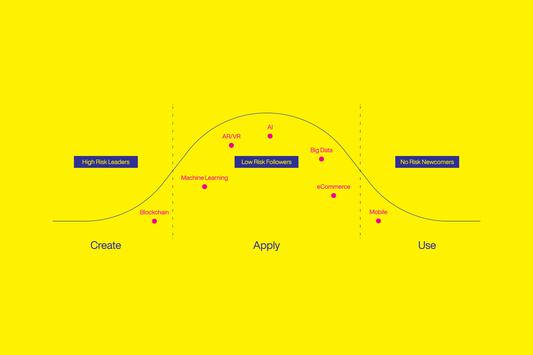
Peopledesign
The Built Environment
Furniture
Lighting
Textiles/Upholstery
Flooring/Carpet
Building Materials
AE Firms
Digital Transformation in Commercial Furniture
Digital Transformation
Leveraging Technology for Innovation
For the last decade, the concept of digital transformation has taken root within nearly every business sector. The promise of digital technologies changing how organizations operate and deliver customer value seems too good to be true – yet completely unavoidable.

Technology innovation can be difficult, particularly for those outside the technology industry. An industry with a history older than Amazon may struggle with these new dimensions. Industries like commercial furniture have been relatively static. Company priorities and product thinking have evolved, but the industrial paradigm of workers going to central places to work has remained unchanged for decades. The kind of change that killed Borders Books and Blockbuster has made all companies uneasy.
Perhaps the most challenging part of digital transformation is the human transformation—processes, skills, training, and change management—rather than the technology itself. Culturally, it means becoming more tolerant of experimentation, taking calculated risks, and failing fast.
Technology is a tool with no inherent value, but new technology creates new possibilities. New access, interactions, and connections can change the game for businesses and industries, with top-line and bottom-line growth opportunities.

Top-line Innovation
Websites are merely one step on a long road to digital transformation, but they’re often where the conversation starts. A company’s digital front door sees more traffic every day than any physical door and opens the promise of many other doors. Digital content is the price of entry.
Consider how technology is blurring roles like sales and marketing. Conversion-focused websites aligned with CRM (Customer Relationship Management) systems and marketing automation programs create the opportunity to improve data collection from lead generation through the sale. In the information age, the best data wins.
Clarifying what customers you seek and how you convert them is an important choice. The new digital landscape changes marketplaces, decreasing the importance of geography and changing expectations. Digital marketing should be far more targeted because customers have far more options.
Buying a CRM is much easier than adopting one. A previous generation of salespeople, valued by the size of their Rolodex (look it up, kids), are not easily persuaded to share their personal sales data. Assuming your salespeople wholly commit to your CRM and all customers are aligned with well-trained salespeople, the CRM can become the source of truth for all sales activity. A robust customer database contains curated and prioritized real-time information. It allows for actionable dashboards for sales activity by region, product category, customer, and vertical market.
Marketing information added to dashboards makes them even more robust, such as information from marketing campaigns, social media, emails, automation, and drip campaigns (focused messages to targeted groups), tradeshow activity (promotions, geotargeting, promotions), news (like new building projects), and trend data (like increased investment in your category).
Centralized customer insights help identify customer patterns, such as seasonality, product pairings, and other leading and lagging indicators of buying behavior.
If your website allows users to save product or project data, this, too, can feed the CRM database. In addition to historical sales information about projects, clients, and projects, a client database may provide a window into future buying intent. Active leads can be flagged and followed up through marketing automation programs and direct outreach. Additional approaches like A/B testing can further optimize marketing and sales.
Specifiers and customers will expect digital specifications for the built environment. Tools that support the design process for visualization and planning continue to advance and become more integrated. Product symbol libraries are already the market expectation. Purchasing platforms are becoming normalized. Over time, these tools will become even more robust, integrating with BIM (Building Information Modeling) and other business management technologies. Customers will expect Amazon-like customer experiences for professional accounts, feature comparison, visualization, technical specifications, usage information, order entry, specials, order status, support, and more.
One ripple effect of adopting new technologies is that roles change. Now, the marketing team acquires leads instead of salespeople knocking on doors. Technologists, content creators, and data analysts are needed. Salespeople have a part in a connected system, focusing on where they add the most value—building relationships and closing deals. Dealers and Reps will need appropriate access to your systems, begging questions about what information will offer the best incentives and help them be most effective. Creating a new framework for your sales/marketing digital ecosystem is an important step.
Together, these changes can expand your reach, scale your efforts, and increase your overall top-line performance.

Bottom-line Innovation
While a glamorous digital front end attracts attention, much of the work happens behind the scenes.
Integrating front-end marketing technologies with back-end systems like ERP (Enterprise Resource Planning) platforms is the dream of moving seamlessly toward a more complete digital transformation. Connecting sales/marketing technologies with order entry, manufacturing, order management, and customer service creates end-to-end connections, improving company efficiency.
Back-end systems can link ordering, order management, manufacturing, shipping, and order status to a robust product database – a central source of truth – for all product data. The customer-facing website can be linked to and fed by the comprehensive product database. This level of integration is an enormous task beyond the technology investment and implementation, forcing data normalization and new internal processes and training. However, the advantages are deep and wide: All this should save money in the long run with less manual labor, reducing duplicate work, fewer mistakes, and faster turnaround.
With additional insights into customer behavior (see above), proactive planning can help optimize manufacturing operations. Production lines and sourcing can be more efficient, and inventory can be more predictable. Increasing the efficiency of manufacturing operations creates opportunities for financial planning, cash flow, and other investments.
Over time, B2B specification processes will look more like B2C e-commerce. Both internal teams and customers will increasingly expect transparency when visualizing, specifying, ordering, order status, change management, shipping status, pricing, and discounts. Trying to do all this manually is nearly impossible (and expensive) and necessitates an investment in digital transformation.
Data mined from a digitized workflow between customer demand and manufacturing supply leads to additional efficiencies. Emerging technologies like AI (Artificial Intelligence) and ML (Machine Learning) promise to better identify patterns by order of magnitude, enabling real-time adjustments.
AI and ML are clearly on the bleeding edge of technology innovation. All companies are scrambling to determine how best to use these new technologies. No one knows precisely where it is going, but the next 3-5 years, let alone the next 10, promise to yield profound changes. At the very least, we know that the volume of data available today has enormous potential, and a new generation of tools will produce even more powerful insights. Much more is on the horizon, likely to automate more parts of internal processes and customer experiences.
In the big picture, digital transformation isn’t merely about making your complex company more digital. It’s about an overall assessment of value creation, how materials and information move through your organization, and envisioning a new world that may work differently. Do you really need all those SKUs? Are you really selling to every vertical market? It may be about simplifying. Strategic product portfolio management, normalizing data, and marketing optimization can increase the predictability and profitability of manufacturing operations. There is a future where you can lead your customers rather than merely react to them, creating an even stronger connection between the front and the back of the house.
Learn From Us
Insights in your inbox!

People Innovation
Technology will augment and, in some cases, replace human interactions, increasing speed, feedback, and data. Any function that can be enhanced or replaced by technology will be. New technology is expensive but less expensive than not investing at all. Ultimately, optimization will drive the cost as low as possible to where people are the most costly part of the equation.
Over time, technology becomes normalized. Mobile apps have become commonplace today, just like website product visualizers, but some are better than others. Some are easier and more pleasurable to use, do more valuable things, and keep us hooked. Once a first-mover advantage is lost, all companies will have sophisticated front-end and back-end technologies, but the difference will be the user experience.
It may seem contradictory, but humans are the most significant challenge with technological innovation. Technology leaders like Amazon, Facebook, Google, and Apple know this well. Technology is not an issue for them – what to do with it is a new problem.
The goal should be understanding, defining, refining, and optimizing the overall CX (Customer Experience). With an increased understanding of buying behaviors and what works, people can focus on customer interactions that require them most. While chatbots seem like an easy answer today, it could be that human customer support mechanisms may increase specifications more than robots will save money. Offering what customers need before they ask for it will be the new currency for brand loyalty.
New insights can inform strategic work, but technology won’t create new business models. Optimized buying patterns point to new directions and have a flywheel effect, where factors outside the technology experience create a brand experience that customers don’t want to leave.
Looking Ahead
Digital transformation is a heavy lift that doesn’t happen overnight. Amazon is a gold standard among digital-first organizations, but the company invested billions of dollars for nearly ten years before reaching consistent profitability. Most companies don’t have that kind of investor tolerance. Amazon and other innovators have blazed a new trail for us to follow, but don’t underestimate what it takes to build a new digital infrastructure.
It’s possible. In The Rise of the Rest, author Steve Case argues that the revolution within many industries will not occur in Silicon Valley, New York, or Boston. Instead, as emerging technologies become ubiquitous, innovation will stem from within industries where that culture is best understood. The commercial furniture industry is in the best place to reinvent itself, but it needs market players with the vision and fortitude to act like a startup again.
Doing nothing is not an option. While digital transformation is daunting, staying ahead means moving faster than the market. Innovation requires self-awareness, humility, and courage. Wherever you are on your journey, know that you are not alone. We all feel this pressure, but moving forward is essential—working together as a team, a company, and an industry to define new futures.


